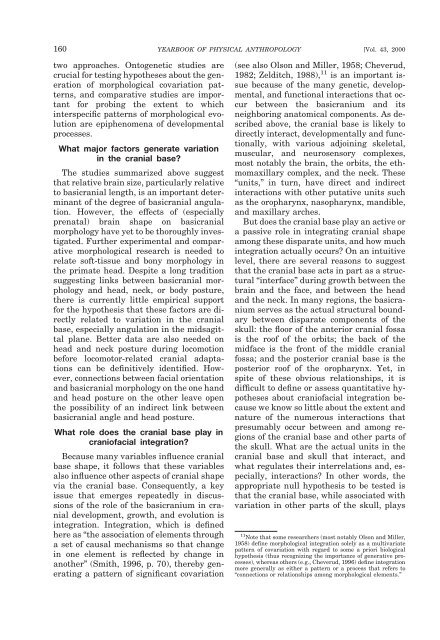The primate cranial base: ontogeny, function and - Harvard University
The primate cranial base: ontogeny, function and - Harvard University
The primate cranial base: ontogeny, function and - Harvard University
Create successful ePaper yourself
Turn your PDF publications into a flip-book with our unique Google optimized e-Paper software.
160 YEARBOOK OF PHYSICAL ANTHROPOLOGY [Vol. 43, 2000<br />
two approaches. Ontogenetic studies are<br />
crucial for testing hypotheses about the generation<br />
of morphological covariation patterns,<br />
<strong>and</strong> comparative studies are important<br />
for probing the extent to which<br />
interspecific patterns of morphological evolution<br />
are epiphenomena of developmental<br />
processes.<br />
What major factors generate variation<br />
in the <strong>cranial</strong> <strong>base</strong>?<br />
<strong>The</strong> studies summarized above suggest<br />
that relative brain size, particularly relative<br />
to basi<strong>cranial</strong> length, is an important determinant<br />
of the degree of basi<strong>cranial</strong> angulation.<br />
However, the effects of (especially<br />
prenatal) brain shape on basi<strong>cranial</strong><br />
morphology have yet to be thoroughly investigated.<br />
Further experimental <strong>and</strong> comparative<br />
morphological research is needed to<br />
relate soft-tissue <strong>and</strong> bony morphology in<br />
the <strong>primate</strong> head. Despite a long tradition<br />
suggesting links between basi<strong>cranial</strong> morphology<br />
<strong>and</strong> head, neck, or body posture,<br />
there is currently little empirical support<br />
for the hypothesis that these factors are directly<br />
related to variation in the <strong>cranial</strong><br />
<strong>base</strong>, especially angulation in the midsagittal<br />
plane. Better data are also needed on<br />
head <strong>and</strong> neck posture during locomotion<br />
before locomotor-related <strong>cranial</strong> adaptations<br />
can be definitively identified. However,<br />
connections between facial orientation<br />
<strong>and</strong> basi<strong>cranial</strong> morphology on the one h<strong>and</strong><br />
<strong>and</strong> head posture on the other leave open<br />
the possibility of an indirect link between<br />
basi<strong>cranial</strong> angle <strong>and</strong> head posture.<br />
What role does the <strong>cranial</strong> <strong>base</strong> play in<br />
craniofacial integration?<br />
Because many variables influence <strong>cranial</strong><br />
<strong>base</strong> shape, it follows that these variables<br />
also influence other aspects of <strong>cranial</strong> shape<br />
via the <strong>cranial</strong> <strong>base</strong>. Consequently, a key<br />
issue that emerges repeatedly in discussions<br />
of the role of the basicranium in <strong>cranial</strong><br />
development, growth, <strong>and</strong> evolution is<br />
integration. Integration, which is defined<br />
here as “the association of elements through<br />
a set of causal mechanisms so that change<br />
in one element is reflected by change in<br />
another” (Smith, 1996, p. 70), thereby generating<br />
a pattern of significant covariation<br />
(see also Olson <strong>and</strong> Miller, 1958; Cheverud,<br />
1982; Zelditch, 1988), 11 is an important issue<br />
because of the many genetic, developmental,<br />
<strong>and</strong> <strong>function</strong>al interactions that occur<br />
between the basicranium <strong>and</strong> its<br />
neighboring anatomical components. As described<br />
above, the <strong>cranial</strong> <strong>base</strong> is likely to<br />
directly interact, developmentally <strong>and</strong> <strong>function</strong>ally,<br />
with various adjoining skeletal,<br />
muscular, <strong>and</strong> neurosensory complexes,<br />
most notably the brain, the orbits, the ethmomaxillary<br />
complex, <strong>and</strong> the neck. <strong>The</strong>se<br />
“units,” in turn, have direct <strong>and</strong> indirect<br />
interactions with other putative units such<br />
as the oropharynx, nasopharynx, m<strong>and</strong>ible,<br />
<strong>and</strong> maxillary arches.<br />
But does the <strong>cranial</strong> <strong>base</strong> play an active or<br />
a passive role in integrating <strong>cranial</strong> shape<br />
among these disparate units, <strong>and</strong> how much<br />
integration actually occurs? On an intuitive<br />
level, there are several reasons to suggest<br />
that the <strong>cranial</strong> <strong>base</strong> acts in part as a structural<br />
“interface” during growth between the<br />
brain <strong>and</strong> the face, <strong>and</strong> between the head<br />
<strong>and</strong> the neck. In many regions, the basicranium<br />
serves as the actual structural boundary<br />
between disparate components of the<br />
skull: the floor of the anterior <strong>cranial</strong> fossa<br />
is the roof of the orbits; the back of the<br />
midface is the front of the middle <strong>cranial</strong><br />
fossa; <strong>and</strong> the posterior <strong>cranial</strong> <strong>base</strong> is the<br />
posterior roof of the oropharynx. Yet, in<br />
spite of these obvious relationships, it is<br />
difficult to define or assess quantitative hypotheses<br />
about craniofacial integration because<br />
we know so little about the extent <strong>and</strong><br />
nature of the numerous interactions that<br />
presumably occur between <strong>and</strong> among regions<br />
of the <strong>cranial</strong> <strong>base</strong> <strong>and</strong> other parts of<br />
the skull. What are the actual units in the<br />
<strong>cranial</strong> <strong>base</strong> <strong>and</strong> skull that interact, <strong>and</strong><br />
what regulates their interrelations <strong>and</strong>, especially,<br />
interactions? In other words, the<br />
appropriate null hypothesis to be tested is<br />
that the <strong>cranial</strong> <strong>base</strong>, while associated with<br />
variation in other parts of the skull, plays<br />
11 Note that some researchers (most notably Olson <strong>and</strong> Miller,<br />
1958) define morphological integration solely as a multivariate<br />
pattern of covariation with regard to some a priori biological<br />
hypothesis (thus recognizing the importance of generative processes),<br />
whereas others (e.g., Cheverud, 1996) define integration<br />
more generally as either a pattern or a process that refers to<br />
“connections or relationships among morphological elements.”
















